Table of Contents
ToggleStep Drill Techniques
In the ever-evolving landscape of manufacturing and construction, precision and efficiency are paramount. The tools that enable these qualities play a critical role in our daily tasks. One such tool is the step drill. This multifunctional drill has gained popularity due to its ability to streamline drilling processes, making it an invaluable asset in various industries. To understand how step drill techniques enhance drilling efficiency, we need to delve into their design, advantages, and practical applications in real-world scenarios.
Understanding Step Drills
A step drill is a specialized tool designed with a conical shape featuring multiple steps, or diameters, that allow it to drill various sized holes without the need for changing bits. This unique design provides a range of hole sizes from one drill. Step drills are typically made from durable materials, ensuring longevity and consistent performance.
The utility of step drills is not just in their design, but also in how they function. When you use a step drill, you can create holes straight, ensuring precision and reducing the risk of damaging the workpiece. The ability to drill multiple sizes using a single tool eliminates the need for frequent tool changes, saving both time and effort. This functionality directly contributes to enhanced efficiency in drilling operations.
Real-World Applications of Step Drills
Step drills have become increasingly popular in various sectors, including construction, electrical, plumbing, and woodworking. Let’s look at specific examples of how they are applied in different fields.
Construction Industry
In the construction industry, time is money. Workers are often pressed for time while ensuring the job is completed accurately. Step drills excel in this environment. For instance, when installing electrical conduits, workers need to drill multiple-sized holes for different sizes of pipes. Instead of switching between indexes for each hole size, a step drill allows them to drill all the necessary sizes in one go. This efficiency not only speeds up the project completion timeline but also minimizes labor costs.
Electrical Wiring
In electrical work, precision is essential. Electricians use step drills to create clean, precise holes in materials such as metal and wood for wiring and conduit installations. For example, if an electrician needs to install a junction box into a metal panel, they can use a step drill to create the appropriate-sized opening quickly and accurately. The reduced chance of error means safer installations, leading to fewer repairs and lower overall costs for both contractors and clients.
Plumbing Applications
Step drills also find their way into plumbing. Plumbers frequently encounter situations where they need to create access holes for pipes. A step drill can once again perform multiple functions. For example, when running new lines through existing structures, a plumber can use a step drill to create holes of various diameters to accommodate different fittings. The versatility of this tool simplifies the planning process, allowing for better project outcomes.
Woodworking Projects
Woodworkers value the consistency and precision that step drills provide. Suppose a carpenter is constructing furniture that requires a series of evenly spaced holes for dowels. By utilizing a step drill, the woodworker can ensure that every hole meets the required specifications without the hassle of changing drill bits. This not only speeds up the project but enhances the overall quality of the finished product.
Benefits of Using a Step Drill
Moving beyond practical applications, the advantages of using a step drill are worth discussing in detail. Customers focus on several key benefits when considering step drills for their projects.
1. Versatility
Step drills are incredibly versatile tools. Since they can create multiple hole sizes, users can reduce their tool inventory. This is particularly advantageous for small businesses or independent contractors who may not have the budget for extensive tool collections.
2. Time-Saving Efficiency
One of the most appealing features of the step drill is its time-saving potential. Whether in construction, electrical work, plumbing, or woodworking, the ability to drill multiple hole sizes without changing bits allows projects to proceed more smoothly, dramatically cutting down on downtime.
3. Precision
The design of step drills allows for clean and precise holes, reducing the risk of damage to the surrounding material. This is especially important in sensitive installations, as clean holes often result in far fewer post-installation repairs.
4. Durability and Cost-Effectiveness
Quality step drills are made from robust materials and can withstand significant wear and tear. This durability translates to fewer replacements and lower overall costs in the long run. Investing in high-quality step drills can pay off as they provide consistent performance over time.
Conclusion: Reevaluating Your Tools
As industries look for ways to improve efficiency and reduce costs, the step drill stands out as an essential tool. Its versatile design, ability to save time, and precision make it an excellent option for professionals across various fields. The presence of step drills in manufacturing and construction demands a reevaluation of our current tools. Are we maximizing our efficiency in our projects? Utilizing step drills can undoubtedly bring a new level of effectiveness to drilling operations, ensuring that we meet our goals without the hassle of frequent tool changes.
In a competitive landscape, businesses that harness the power of step drills are better positioned to deliver superior results. By integrating step drills into their operations, they can save time, reduce costs, and enhance the quality of their work. It is clear that step drills are much more than mere tools; they are key drivers in achieving operational efficiency in today’s demanding work environments.
In summary, the step drill is an indispensable tool for those focused on drilling efficiency, offering multiple benefits that cater to a variety of needs. By investing in this adaptable and efficient drill, professionals ensure smoother, faster, and more precise operations in their daily tasks. The future of drilling efficiency lies firmly in the hands (and tools) of those willing to embrace innovation—like the step drill.
